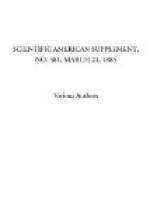The electromotive force and resistance is constant if the velocity is constant. The electromotive force is independent of the velocity, but diminishes as the moisture increases, and is about equal to 52,000 Daniell cells. The resistance when making 120 revolutions per minute is 2,810 million ohms. At 450 per minute, 646 million.
Taking it at 450, C = 53950/64600000.001 = 0.0000835 ampere, against the Professor’s 50,000,000, amperes, and it would be equal to about 0.006 horse power, which I think would be the more correct of the two; calling E equal to 50,000 Daniell cells.
Yours, Respectfully,
E. ELLSWORTH.
Portland, Me., March 5, 1885.
* * * * *
A VISIT TO CANADA AND THE UNITED STATES IN THE YEAR 1884.
[Footnote: A lecture delivered before the Society of Telegraph Engineers and Electricians, London, Dec. 11, 1884.]
By Mr. W.H. PREECE, F.R.S.
I do not know what the sensations of a man can be who is about to undergo the painful operation of execution; but I am inclined to think his sensations must be somewhat similar to those of a lecturer, brimful of notes, who has to wait until the clock strikes before he is allowed to address his audience.
The President has been kind enough to refer to the paper I propose to give you, as “Electricity in America in the year 1884;” but I would rather, after having thought more about it, that it be called “A Visit to Canada and the United States in the year 1884.”
It will be in the recollection of a good many who are present that in the year 1877 I visited America, in conjunction with Mr. H.C. Fischer, the Controller of our Central Telegraph Station, to officially inspect and report upon the telegraph arrangements of that country; and on the 9th February, 1878, I had the pleasure of communicating to the members of this Society my experiences of that visit.
During the present year my visit was not an official one; I went for a holiday, and specially to accompany the members of the British Association, who, for the first time in the history of that association, held a meeting outside the limits of the United Kingdom.




